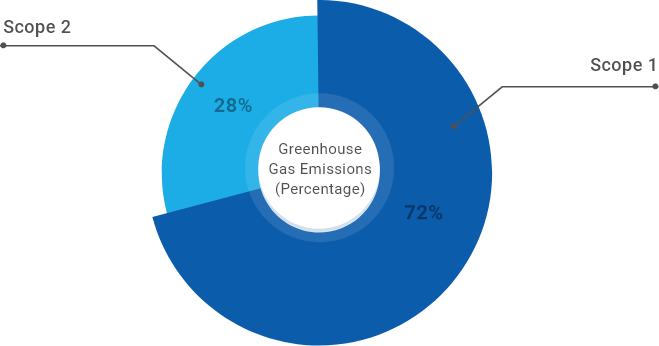According to the Global Risks Report 2020 published by the World Economic Forum (WEF), environmental issues such as extreme weather events, natural disasters, water crises, and failure of climate change adaptation have been listed as critical risks for many years. In the light of the warnings indicated in the "Global Warming of 1.5ㆍC" released by the Intergovernmental Panel on Climate Change (IPCC) in October 2018, it is imperative to make every effort to limit warming to 1.5'C by 2030, so as to avoid significant sea level rises, climate change, sharp declines in food and ecological disasters. In view of the potential risks and impacts of environmental changes and water shortages on business activities, Novatech collects and analyzes the reports on the impacts of climate change to assess and identify relevant risks and opportunities, and searches for responses and management approaches to such risks and opportunities. With sound climate governance and core technologies in place, we apply ourselves to mitigating the impacts of climate change in cooperation with our clients.
In 2019, we included "climate change adaptation strategies" as one of the material issues. Potential risks and opportunities of climate change in the market, legal and physical aspects were identified and classified, as well as potential financial impacts of relevant issues, based on which responses and management approaches were put forward.
Management Approach
| Disclosure | Novatech's Practices |
|---|---|
| Importance | Make active responses to the impacts of climate change, an important issue in global business management, such as amendments to regional laws and regulations, green products/services development, business management adaptation, and the emergence of responsible investment, through enhanced climate change adaptation and mitigation |
| Management strategies | Refer to the Task Force on Climate-related Financial Disclosures (TCFD) recommendations for establishing the procedure for identifying the risks and opportunities of climate change, drawing up strategies and measures for managing relevant issues, and gradually setting up systematic and scientific management mechanisms that mirror the UN SDG 13: Climate Action. |
| Policies/commitments |
|
| Goals and targets |
|
| Responsibility | President |
| Resources | Secretary of Board of Directors and Supporting Center |
| Grievance mechanisms | Company website: Stakeholder/Stakeholders Communication Channels Integrity: President and Auditing Office Email:Audit@novatech.com.tw Tel:03-6676868 Ways of communication: email, telephone, and face-to-face interview |
| Action plans |
|
| Effectiveness assessment |
|
| Responses to Risks and Opportunities of Climate Change | |||
|---|---|---|---|
| Category | Identification of Risks and Opportunities | Potential Impact on Finances | Responses |
| Transition risks | Market - Results of Identification | ||
|
Risks With increasing attention to climate change and environmental issues around the globe, our clients give more weight to whether we can provide energy conservation/green energy and other related technical support to satisfy their needs. Failure to deliver will definitely take a toll on our business performance and competitiveness. |
|
|
|
|
Opportunities As the economic model changes, demand for existing products or new products increases, thus creating new business opportunities. |
|
|
|
| Legal - Results of Identification | |||
|
Risks Environmental and climate change laws and regulations at home and abroad have no significant impacts on our business performance for the time being, but continuous follow-up is needed. World governments are establishing regulations on greenhouse gas emissions, and international agreements are now specific on reduction targets. |
|
|
|
|
Opportunities Government policies and related laws and regulations are conducive to the business activities of the Environmental Protection and Green Energy Group. |
|
|
|
| Physical risks | Physical - Results of Identification | ||
|
Risks Climate change may cause water shortages, interruptions in the supply of raw materials or increases in diseases, which affects the supply chain and increases procurement costs. Extreme weather may cause accidents such as project delays, property losses, and casualties. |
|
|
|
|
Opportunities We can take advantage of our expertise to mitigate clients' damage caused by climate change and improve competitiveness. |
|
|
|
In readiness for the risks and opportunities of climate change that may take a toll on the business activities of the Company, we started to cooperate with internationally-renowned desalination companies in 2017 in applying desalination to companies that consume a considerable amount of water such as power plants and large factories, so as to mitigate the impact of water shortages; through cooperation with internationally-renowned companies, we also recover waste chemicals of clients from the science parks to reduce the discharge of waste and sewage and carbon emissions and to increase the clients' water recycling rate, further achieving a circular economy. With innovative construction methods and a wealth of achievements, Novatech continues to provide energy conservation, waste reduction and other related engineering services for clients in different industries.
Our representative technologies include low-temperature sludge drying, high-efficiency thin-film oil and gas recovery equipment, high efficiency denitration system, and developer waste chemical recovery and supply equipment. In the future, we will continue investing in research and development in hopes of achieving environmental sustainability through more sophisticated and innovative technologies.

Energy Utilization and Performance
Novatech is always an advocate and adopter of the idea of environmental protection. The idea of energy conservation and carbon reduction has been put into practice at work with initiatives taken to increase employees' environmental awareness and further contribute to the sustainable development of our planet. By checking on and reviewing energy consumption on a regular basis, we are able to effectively manage energy efficiency in day-to-day business operations. At Novatech, energy utilization, which mainly consists of office electricity and company car fuel, is simpler than that in traditional manufacturing or other industries due to our industrial characteristics and scope of business. The scope of energy utilization includes our branches in North, Central and South Taiwan (Zhubei, Linkou, Zhongli, Taichung, and Taiwan branches).
At Novatech, company car fuel accounts for the largest percentage of energy consumption. The energy consumption of the branches in North, Central and South Taiwan totaled 3,930.89 GJ in 2019, including an electricity consumption of 178,190 kWh and a fuel consumption of 100,745 liters, which was a 103.88 GJ (-2.57%) decrease from 2018. In terms of electricity intensity, the energy intensity in 2019 was 5.57 GJ/ping, down 0.64 GJ/ping (-10.31%) from 2018. In 2019, operations or branches increased as a result of new clients and expansions of construction sites under contract, so the fuel consumption increased by 0.26% from 2018. In the future, we will continuously encourage employees to use mass transportation more instead of driving company cars, so as to protect the environment without prejudice to official business. With continuous dissemination and implementation of energy conservation initiatives, our electricity consumption in 2019 was reduced by 15.11% from 2018.
| Year | Electricity consumption (kWh) | Fuel consumption (liter) | Total energy consumption (GJ) | Total floor area (ping) | Energy intensity (GJ/ping) |
|---|---|---|---|---|---|
| 2017 | 183,612 | 95,972 | 3,792.75 | 590.5 | 6.42 |
| 2018 | 209,906 | 100,488 | 4,034.77 | 649.2 | 6.21 |
| 2017 | 178,190 | 100,745 | 3,930.89 | 706 | 5.57 |
Energy intensity (GJ/ping)
Note 1: Fuel consumption was calculated based on the average price of unleaded gasoline 95 in 2019 (NT$28.5/liter) announced by the Ministry of Economic Affairs on the Petroleum Price Information Management and Analysis System (https://www2.moeaboe.gov.tw/oil102/). Fuel expenses included subsidies for company cars and private cars.
Note 2: Purchased electricity was calculated at 3.6 GJ per thousand kWh; diesel and gasoline were converted based on the heating value of the "Unit Heating Value of Energy Product" announced by the Bureau of Energy, Ministry of Economic Affairs in 2018.
Greenhouse Gas Emissions Management
With extended discussions on global warming, the central and local governments of Taiwan have adopted a more stringent strategy for greenhouse gas management in recent years. Although we are not among the companies that are subject to greenhouse gas review and registration, we take the initiative in disclosing carbon emissions to review our carbon management performance and to respond to climate change mitigation and adaptation as a responsible corporate citizen. Novatech has been committed to reducing the consumption of resources on our planet. In terms of greenhouse gas management, we continue disseminating the concept of energy conservation and carbon reduction to increase employees' awareness while requesting employees to turn off lights after use in course of performing official duties to maintain safety and energy efficiency at the same time. According to the analysis of greenhouse gas emissions in 2019, Scope 1 greenhouse gas emissions were the main source of emissions from our business operations. Scope 1 emissions reached 239.02 metric tons of CO2e, and Scope 2 emissions were 94.98 metric tons of CO2e, totaling 333.99 metric tons of CO2e. In the future, we will continue our endeavor to complete the calculation of Scope 3 emissions, so as to implement the climate management system and structure to perfection.
| carbon dioxide (CO2) equivalent (ton CO2e) | ||
|---|---|---|
| Year | Scope 01:Mobile、Gasoline | Scope 02:Stationary、 Purchased electricity |
| 2017 | 227.69 | 101.72 |
| 2018 | 238.41 | 111.88 |
| 2019 | 239.02 | 94.98 |

Note 1: We calculated greenhouse gas emissions based on energy consumption and the default coefficients of the "Greenhouse Gas Emission Coefficient Management Chart Version 6.0.4" announced by the Environmental Protection Administration, Executive Yuan. The types of greenhouse gases included CO2, CH4 and N2O. The global warming potential (GWP) in the Fourth Assessment Report of the IPCC was used as a basis for calculating the carbon dioxide equivalent.
Note 2: The greenhouse gas emission coefficient for gasoline in Scope 1 was 2.3725 kg CO2e/liter.
Note 3: The emission coefficient for power grids was calculated based on the emission coefficient for electricity of the "2018 Emission Coefficient for Electricity" announced by the Bureau of Energy, Ministry of Economic Affairs. Since the "2019 Emission Coefficient for Electricity" had not yet been announced, the previous year's coefficient (0.533 kg CO2e /kWh) was used.
Energy/Resource Efficiency Measures
Novatech integrates energy/resource efficiency into business strategies with the view of fulfilling our commitment to environmental sustainability. To achieve this, we promote the idea of energy conservation and carbon reduction from time to time, hoping that every employee will turn off the lights after use in day to-day business operations; electronic management systems are also in place to cut down on paper and electricity consumption and increase productivity at the same time. In addition, we request employees to use mass transportation (e.g., trains, high speed railways, MRT and coaches/buses) more often, so as to reduce CO2 and N2O emissions from transportation between offices and branches. To make energy conservation and carbon reduction every employee's habit, the Company adopts various energy saving measures such as regular maintenance and replacement of office equipment with energy labels (inverter air conditioning, T5 lighting, etc.) and central air conditioning and lighting in public spaces. Novatech will continue exploring opportunities to improve energy efficiency, making energy conservation one of our corporate cultures.
Energy Saving Measures at Novatech

Set the indoor air temperature at up to 26°C in the office

Put printers into a sleep mode when idling for 15 minutes

when idling for 15 minutes Equip computers with a power saving mode

Turn off the lights for one hour during lunch break in the office

Close the doors and windows while air conditioning is in operation to seal in cold air

Set auto-off for air conditioning in the office at 5:30 p.m. every day after work

